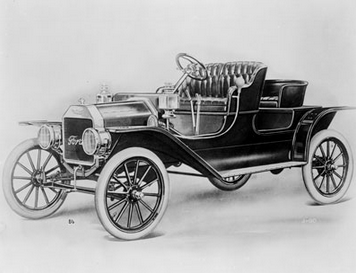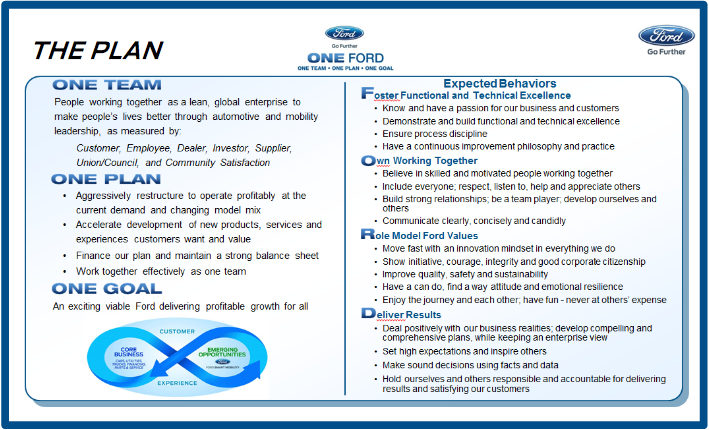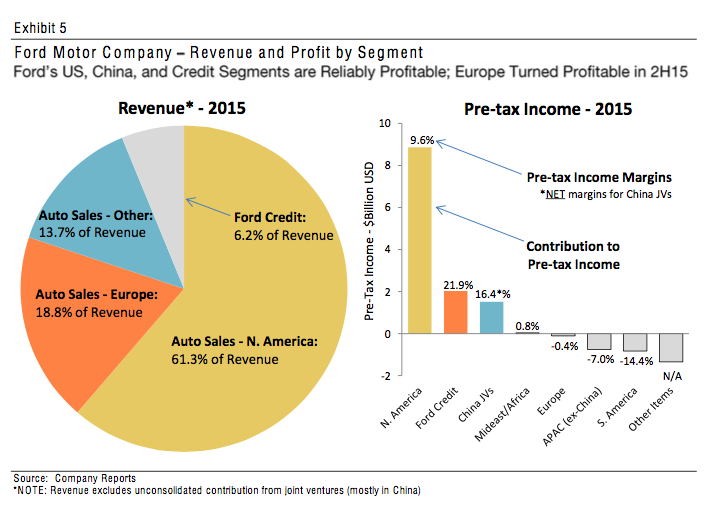Ford’s most challenging days may be ahead
America’s automakers face a storm of challenges. Expectations for automakers have been shrinking following a record year in 2015 for sales, just as the industry is embarking on a significant technological transformation, including self-driving cars, electric vehicles and ride sharing services.
Ford, the iconic American $50 billion company known for its F-150 truck and Mustang, has a long history of rising above challenges in the industry as well as navigating through economic crises. While its history is not unblemished, it is one of a handful of American companies that have been in business for over a hundred years. If history is an indicator of the future, Ford may be able to come out on top again.
Rethinking manufacturing and worker pay
Henry Ford invented the first automobile, the Model T, that many middle class Americans could afford, in 1908.

By using the assembly line to reduce the Model T’s production time from 12.5 hours to 1.5 hours, Ford introduced a revolution in manufacturing, lowering costs and creating a vehicle for the masses.
By 1914, it was estimated that nine out of every 10 cars on the road were Fords. Ford sold 15 million Model Ts before ending production in 1927, and even today it marks the third best selling vehicle of all time. Even before it lost out to later models, the Model T—also known as the “Tin Lizzie” or the “flivver” had become an American symbol that allowed the company to democratize the automobile.
Also importantly, Henry Ford was known for a transformation in company-employee relations. He instituted the famous “$5 Day” in 1914, double the pay rate for factory workers, while reducing the work day from nine hours to eight hours. Instead of $2.34 for nine hours, most workers would make $5.00 for eight hours.
The day after the “$5 Day” was announced, an estimated 10,000 people lined up outside Ford’s employment office looking to be hired. The increased pay also contributed to employee retention.
Later on, in 1941, Ford signed its first contract with the UAW-CIO to guarantee better pay and conditions for workers.
In 1956, Ford became a publicly traded company and continued to grow—the name becoming synonymous with the auto industry.
Weathering the crisis
More recently, Ford and the auto industry were associated with the financial crisis of 2009.
Unlike its competitors like General Motors (GM) and Chrysler (FCAU), Ford didn’t need any bailouts during the recession. Following the appointment of Alan Mulally, who came from Boeing (BA), as Ford CEO in September 2006, the company immediately developed a leaner structure, putting it in a better position ahead of the recession. Ford announced the sale of its Aston Martin brand in March 2007 and Jaguar/ Land Rover in March 2008 while starting a process to sell Volvo, which was announced in March 2010. This left the company with the core Ford and Lincoln brands.
Most importantly, though, in November 2006, Alan Mulally raised $23.6 billion from banks. While the economy was healthy then, Mulally said the money would give Ford “ a cushion to protect for a recession or other unexpected event.” On the job for less than three months when raising capital, Mulally was prepared to streamline business and give the automaker a healthier financial backbone.The company’s motto, “Built Ford Tough” rang true as it pulled out of the recession, cleaning up its balance sheet—including a $10 billion debt restructuring in March 2009.
Mulally’s very simple operating message for the company, “One Ford,” reflected his operational and financing vision of a simpler company that could benefit from its scale to boost margins and increase volumes.

Ford today
Today, Ford remains a leader in the auto industry—selling 6.6 million vehicles in 2015. Ford, which still generates the majority of its revenue and income from North America with 15% market share, has placed new importance on areas like China. Current CEO Mark Fields aims to expand “One Ford” on a more global scale to improve efficiency and profitability worldwide.

But new challenges face the automaker, which benefitted an industry-record 17 million units sold last year from lows of 10 million during the downturn.
Fields has acknowledged that the industry has plateaued and, importantly, has made efforts to position itself as more of a technology company, embracing self-driving cars and mobility services.
Certainly the automaker strives to pull from its innovative roots under Henry Ford to stay in front of the rapid changes the industry is undergoing.
On September 12 and 13, Yahoo Finance will exclusively live stream key interviews from the 2016 Further with Ford Trend Conference.

